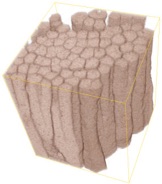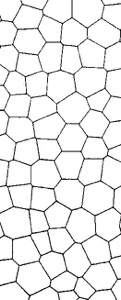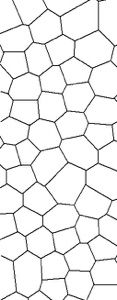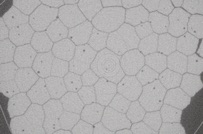
Starch colonnades
My experiments centered around the desiccation of corn starch slurries. The unusual patterns that wet starches produce when dried were already noted, in the 19th century, by T. H. Huxley. More recently, the patterns in starch have been used as a model for studying fracture in other situations.
Columnar jointing is a peculiar self-organized fracture pattern, and is a commonly seen in cooled lava. I concentrated on explaining two aspects of this problem. First, scaling - why are columnar joints in starch one size under certain conditions, and another size under different conditions. How is their size chosen? Secondly, ordering - why does a pattern of mostly hexagonal cross-sectional columns develop, and how can we best describe that pattern.


Observation and Tomography
Columnar jointing is an inherently 3D problem. This raises problems of visualization and observation. Starch is opaque. So are lavas. Historically, measurements were confined to either an exposed cross-section of a colonnade, or to a collection of column faces along a cliffside. This leaves the obvious question: how does one observe the 3D structure of the cracks?
I developed two simple methods of visualizing the internal structure of starch colonnades. In many cases, I was able to destructively sample dried starchcakes - imaging layer after layer as the cake is successively sawn apart. One can patiently extract information about the state of a sample by these means. However, to really reconstruct the crack pattern, I used micro-computed X-ray tomography to obtain volume-filling images of starch colonnades. These superb images allowed me to look closely at how the fracture network initiates in a disordered way, and how it organizes itself into a mostly hexagonal pattern.
A drying experiment.

Tomograph image
Pattern ordering
Initially, the fracture network that appears near a drying or cooling surface is disordered, and looks like the cracks seen in a mud puddle. The physics giving rise to the formation of these surface cracks are related to the physics of thin-film fracture.
As the crack tips intrude into the drying sample, they trace out an evolving network, which orders. In starch samples, it seems as if the ordering takes place within the initial centimeter of fracture. Once ordered, this network remains statistically self similar throughout further evolution; the description does not seem to depend on the scale of the pattern. This ‘mature’ pattern, however, retains substantial disorder. By comparing the pattern from starch slurries to a survey of the famous Giant’s causeway, there is a remarkable correspondence in the amount of residual disorder between these two realizations of columnar jointing.


Crack pattern of columnar jointing in basalt (left) and starch (right)
Scaling and controlled desiccation
It has been argued that, for lava, the length scale observed in columnar jointing (be it side length, column diameter, or something related to the column area), is somehow derived from the cooling rate. Analogously, in drying starch, it is the evaporation rate which should control the scale-selection process.
In a series of experiments where the mass of the drying sample was measured continuously during drying, and where the evaporation rate was controlled by a feedback cycle, I studied how the pattern scale is chosen. I found that, if the evaporation rate is fixed to a constant value during drying, that a particular columnar scale is also chosen. If the evaporation rate is allowed to decrease during drying, the column scale coarsens during drying, although it can respond hysterically, or with sudden changes in scale. In all cases, however, the scale that appears is inversely proportional to the evaporation rate.

Controlled desiccation selects a well defined pattern scale.
Tomograph cross-section scan
(click image to watch)
References
Further information on my desiccating corn starch experiments can be found in my publications on this subject:
L. Goehring. Drying and cracking mechanisms in a starch slurry, Phys. Rev. E, 80, 036116 (2009) [abstract] [preprint]
L. Goehring, L. Mahadevan and S. W. Morris. Scale selection in columnar joints Proc. Nat. Acad. Sci. 106 (2), 387-392, (2009). [abstract] [preprint]
L. Goehring, S. W.Morris, and Z. Lin. Experimental investigation of the scaling of columnar joints. Phys. Rev. E, 74, 036115, (2006). [abstract] [preprint]
L. Goehring and S. W. Morris. Order and disorder in columnar joints. Europhyics Letters, 69 (5), 739-745, (2005). [abstract] [preprint]

Experiments
